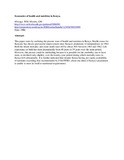| dc.contributor.author | Mwangi, WM | |
| dc.contributor.author | Mwabu, GM | |
| dc.date.accessioned | 2013-08-07T08:14:19Z | |
| dc.date.available | 2013-08-07T08:14:19Z | |
| dc.date.issued | 1986 | |
| dc.identifier.citation | Soc Sci Med. 1986;22(7):775-80 | en |
| dc.identifier.uri | http://www.ncbi.nlm.nih.gov/pubmed/3086981 | |
| dc.identifier.uri | http://erepository.uonbi.ac.ke:8080/xmlui/handle/123456789/55099 | |
| dc.description.abstract | This paper starts by outlining the present state of health and nutrition in Kenya. Health status for Kenyans has shown spectacular improvement since Kenya's attainment of independence in 1963. Both the infant mortality and crude death rates fell by about 30% between 1963 and 1982. Life expectancy at birth has risen dramatically from 40 years to 54 years over the same period. However, this picture could be misleading because it is possible for the morbidity rate to have risen, or declined only slightly, over the twenty-year period during which mortality rates in Kenya fell substantially. It is further indicated that despite Kenya having per capita availability of nutrients exceeding that recommended by FAO/WHO; about one-third of Kenya's population is unable to meet its food or nutritional requirements. | en |
| dc.language.iso | en | en |
| dc.publisher | University of Nairobi | en |
| dc.title | Economics of health and nutrition in Kenya. | en |
| dc.type | Article | en |
| local.publisher | School of Economics | en |

